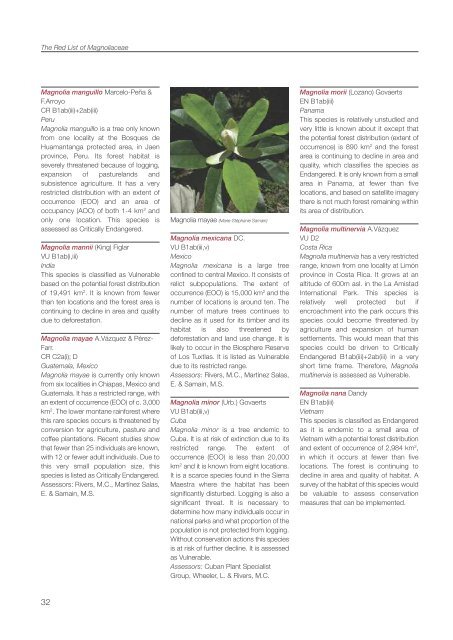Magnoliaceae
Magnoliaceae_RedList_2016_LowRes
Magnoliaceae_RedList_2016_LowRes
Create successful ePaper yourself
Turn your PDF publications into a flip-book with our unique Google optimized e-Paper software.
The Red List of <strong>Magnoliaceae</strong><br />
Magnolia manguillo Marcelo-Peña &<br />
F.Arroyo<br />
cR B1ab(iii)+2ab(iii)<br />
Peru<br />
Magnolia manguillo is a tree only known<br />
from one locality at the Bosques de<br />
Huamantanga protected area, in Jaen<br />
province, Peru. Its forest habitat is<br />
severely threatened because of logging,<br />
expansion of pasturelands and<br />
subsistence agriculture. It has a very<br />
restricted distribution with an extent of<br />
occurrence (EOO) and an area of<br />
occupancy (AOO) of both 1-4 km 2 and<br />
only one location. This species is<br />
assessed as critically Endangered.<br />
Magnolia mannii (king) Figlar<br />
VU B1ab(i,iii)<br />
India<br />
This species is classified as Vulnerable<br />
based on the potential forest distribution<br />
of 19,491 km 2 . It is known from fewer<br />
than ten locations and the forest area is<br />
continuing to decline in area and quality<br />
due to deforestation.<br />
Magnolia mayae A.Vázquez & Pérez-<br />
Farr.<br />
cR c2a(i); D<br />
Guatemala, Mexico<br />
Magnolia mayae is currently only known<br />
from six localities in chiapas, Mexico and<br />
Guatemala. It has a restricted range, with<br />
an extent of occurrence (EOO) of c. 3,000<br />
km 2 . The lower montane rainforest where<br />
this rare species occurs is threatened by<br />
conversion for agriculture, pasture and<br />
coffee plantations. Recent studies show<br />
that fewer than 25 individuals are known,<br />
with 12 or fewer adult individuals. Due to<br />
this very small population size, this<br />
species is listed as critically Endangered.<br />
Assessors: Rivers, M.c., Martínez Salas,<br />
E. & Samain, M.S.<br />
Magnolia mayae (Marie-Stéphanie Samain)<br />
Magnolia mexicana Dc.<br />
VU B1ab(iii,v)<br />
Mexico<br />
Magnolia mexicana is a large tree<br />
confined to central Mexico. It consists of<br />
relict subpopulations. The extent of<br />
occurrence (EOO) is 15,000 km 2 and the<br />
number of locations is around ten. The<br />
number of mature trees continues to<br />
decline as it used for its timber and its<br />
habitat is also threatened by<br />
deforestation and land use change. It is<br />
likely to occur in the Biosphere Reserve<br />
of Los Tuxtlas. It is listed as Vulnerable<br />
due to its restricted range.<br />
Assessors: Rivers, M.c., Martínez Salas,<br />
E. & Samain, M.S.<br />
Magnolia minor (Urb.) Govaerts<br />
VU B1ab(iii,v)<br />
Cuba<br />
Magnolia minor is a tree endemic to<br />
cuba. It is at risk of extinction due to its<br />
restricted range. The extent of<br />
occurrence (EOO) is less than 20,000<br />
km 2 and it is known from eight locations.<br />
It is a scarce species found in the Sierra<br />
Maestra where the habitat has been<br />
significantly disturbed. Logging is also a<br />
significant threat. It is necessary to<br />
determine how many individuals occur in<br />
national parks and what proportion of the<br />
population is not protected from logging.<br />
Without conservation actions this species<br />
is at risk of further decline. It is assessed<br />
as Vulnerable.<br />
Assessors: cuban Plant Specialist<br />
Group, Wheeler, L. & Rivers, M.c.<br />
Magnolia morii (Lozano) Govaerts<br />
En B1ab(iii)<br />
Panama<br />
This species is relatively unstudied and<br />
very little is known about it except that<br />
the potential forest distribution (extent of<br />
occurrence) is 890 km 2 and the forest<br />
area is continuing to decline in area and<br />
quality, which classifies the species as<br />
Endangered. It is only known from a small<br />
area in Panama, at fewer than five<br />
locations, and based on satellite imagery<br />
there is not much forest remaining within<br />
its area of distribution.<br />
Magnolia multinervia A.Vázquez<br />
VU D2<br />
Costa Rica<br />
Magnolia multinervia has a very restricted<br />
range, known from one locality at Limón<br />
province in costa Rica. It grows at an<br />
altitude of 600m asl. in the La Amistad<br />
International Park. This species is<br />
relatively well protected but if<br />
encroachment into the park occurs this<br />
species could become threatened by<br />
agriculture and expansion of human<br />
settlements. This would mean that this<br />
species could be driven to critically<br />
Endangered B1ab(iii)+2ab(iii) in a very<br />
short time frame. Therefore, Magnolia<br />
multinervia is assessed as Vulnerable.<br />
Magnolia nana Dandy<br />
En B1ab(iii)<br />
Vietnam<br />
This species is classified as Endangered<br />
as it is endemic to a small area of<br />
Vietnam with a potential forest distribution<br />
and extent of occurrence of 2,984 km 2 ,<br />
in which it occurs at fewer than five<br />
locations. The forest is continuing to<br />
decline in area and quality of habitat. A<br />
survey of the habitat of this species would<br />
be valuable to assess conservation<br />
measures that can be implemented.<br />
32


